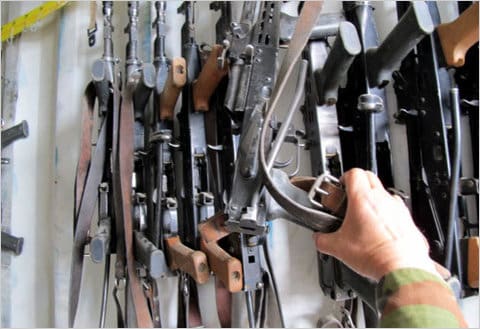Under the Fair Use law, I can’t republish entire articles without permission. The exact limits of acceptable scrapage are open to debate, and subject to common sense (i.e., I can copy and paste enough material to make people want to link across, but not so much that they won’t bother). That’s not as much of a limitation as it is a challenge: to find the section that best encapsulates the writer’s ideas. With New York Times war correspondent C.J. Chivers’ work, I find my editorial skills stretched. Here’s my digital sample from today’s masterwork . . .
The Afghan noncommissioned officer reaching into the frame above really wanted to show me this particular rifle. Have a look. The rifle is slightly blackened by fire and is missing its receiver cover. This weapon — along with another AMD-65, a rocket-propelled grenade launcher and a PK derivative — had been damaged when an Afghan National Army team was hit in an American airstrike about a year ago . . .
After the sergeant showed me this rifle, he took me to another, and insisted I look it over closely. It had blood stains and something hard wedged up under its handguard. I couldn’t quite tell what it was. So I asked.
“Human meat,” he answered.
Some of the flesh of the Afghan soldiers who had been hit in the airstrike had been blown against the weapon, and after the rifles had been carried back by survivors to the armory, the Afghan unit had not troubled to clean them. With the passage of time in Band-e Sardeh’s arid climate, the flesh had hardened, like jerky.
Why not clean this, I asked. Like many things undone in Afghanistan, this would seem a pretty fundamental step.
The sergeant shrugged. He insisted that I take a photograph. There is no need to show it here. We talked for a few minutes, but no one could quite recall the dead soldiers’ names. Only their weapons were here, to be reused or cannibalized for parts. Rifles, at least, like dams, get many lives.




